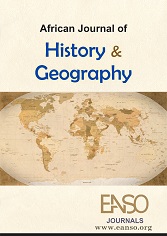Stateless Minorities: A Case Study of the Rundi and Kenyans of Rwandese Descent
Ikisiri
Kenya is a multi-ethnic country, with over 40 different ethnic groups. Various ethnic groups living in Kenya have existed in constant warfare due to the unequal distribution of resources. However, the situation is worsened by the existence of stateless communities within the country. In Kenya, just like other African countries, there have existed stateless communities such as the Rundi, descendants from Malawi and Kenyans of Rwandese descent. This article examines stateless communities with a case example of the Rundi and Kenyans of Rwandese descent. The article argues that lack of recognition of these communities not only leads to abuse of human rights but also poses a threat to national security. Since their settlement in Kenya, the Rundi and Kenyans of Rwandese descent are yet to gain official recognition by the Kenyan government. This has greatly affected the economic, social and political growth of these communities since their growth is greatly pegged on having official documents that recognize them as Kenyan citizens. The article also highlights the effects of statelessness in the country. The study is guided by the Relative Deprivation theory which posits that inequalities among groups and regions are likely to cause conflict and undermine national cohesion
Upakuaji
Marejeleo
Alcorta et al., Universal Ownership in the Anthropocene: Aligning Shareholders Capital with Stakeholders and Societal Interests, (United Nations University World Institute for Development Economics Research, Finland, 2020
Barry, B. M. (2001). Culture and equality: an egalitarian critique of multiculturalism. Cambridge, Polity Press.
Etefa, T. (2019). The Origins of Ethnic conflicts in Africa: Politics and Violence in Darfur, Oromia and the Tana Delta. Palgrave Macmillan.
M. Francis, The Colonial Moment in Kenya: The Politics of the Crown, Colonial Administration and the Bureaucracy, 1900-1952 (Cambridge: Cambridge University Press,1975) pp. 80-
T.R. Gurr, Minorities at Risk: A Global View of Ethno political conflicts, (Washington DC: United States of Peace Press, 1993), pp.25-30
Kenya Human Rights Commission Report. Killing the vote: State Sponsored Violence and Flawed Elections in Kenya ( Nairobi, Kenya: Kenya Human Rights Commission, 1998).
Littlejohn, S. W. & Foss, K.A. (2011). Theories of Human Communication (10th ed.) Waveland Press.
Messiou, K. (2006). Conversations with children: making sense of marginalization in primary school settings. European Journal of Special Needs Education, 21(1) 39-54.
Ministry of Justice, National cohesion and Constitutional Affairs. (2012). National cohesion and Integration policy (shorter vision). PDF retrieved January 10, 2013.
J. S. Mill, On Liberty, (Indiana: Hackett Publishing Company, 1978), pp. 70-80
R. Muhula, Horizontal Inequalities and Ethno- regional politics in Kenya (NewYork: Palgrave Macmillan, 2014) pp 9-20
Ochieng’ W. R., Maxon RM eds. An Economic History of Kenya. (Nairobi, Kenya: East African Educational Publishers Ltd, 1992
Ochieng WR ed A Modern History of Kenya: In Honour of Professor B.A Ogot. (Nairobi, Kenya: Evans Brothers, 1989).
Ogot B.A and Ochieng W.R, eds. Decolonization& Independence in Kenya, 1940-1993.(London: James Currey, 1996)
B.A Ogot and W.R. Ochieng (Eds). “The Making of a Nation”. (Maseno: Institute of Research and Postgraduate Studies, 2000), pp 16-31
Ogot, B.A. (2000). “Boundary Changes and the Invention of “Tribes”, Ogot, B. A. and Ochieng, W. R. (Eds.) (2000) Kenya: The Making of a Nation. Maseno: Institute of Research and Postgraduate Studies (pp 16-31).
Oyugi, W. (1997). “Ethnicity in the Electoral Process: The 1992 General Elections in Kenya”. African Journal of Political Science 2(1) 41–69.
J. Rousseau, Discourse on Inequality: On the Origin and Basis of Inequality Among Men. (Australia: Floating Press, 2009) pp.40- 50
F. Stewart, Horizontal inequalities: A neglected dimension of development. (2002). QEH Working Paper Number 81. Queen Elizabeth House, University of Oxford.
Thomson, A. (2004). An Introduction to African Politics (2nd eds). Routledge. Taylor and Francis. Stewart F (2002). Horizontal inequalities: A neglected dimension of development. QEH Working Paper Number 81. Queen Elizabeth House, University of Oxford.
Throup, D. ,w. and Charles H. Multi- Party Politics in Kenya: The Kenyatta and Moi States and the Triumph of the system in the 1992 Election (Oxford, United Kingdom: James Currey Ltd, 1998). Mayoral (2019
Idowu, J. & Azeez O. (2017). The politics of renewed quest for a Biafra Republic in Nigeria. Defense & Security Analysis, 33(4) 320-332
Jenson, J. (2010). Defining and Measuring Social Cohesion. Commonwealth Secretariat. MJNCCA, 2012
Raleigh, C. (2010). Political Marginalization, Climate Change and Conflict in African Sahel States. International Studies Review (12) 69-86.
Copyright (c) 2024 Jacqueline Wanjiku

This work is licensed under a Creative Commons Attribution 4.0 International License.




























